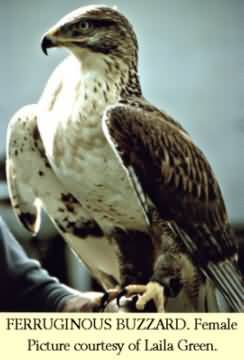
FERRUGINOUS BUZZARD.
Buteo regalis
IDENTIFICATION. The plumage of a Ferruginous Buzzard is quite beautiful. The throat, chest, underside of wings and occasionally the legs are cream with streaks and spots of varying shades of brown. The head is streaked brown and cream leading into the darker browns and streaks of the upper wings and back.
The Ferrug's size (dimorphism) is quite noticeable with the females being much larger than the males. In comparison to their body size the feet of the Ferruginous Buzzard are quite small. The females are capable of taking hare whilst the male will catch creatures as small as locust. Both sexes have a wide bill and appear very intelligent. The odd proportions of the body may be an ingenious method of survival. A large bill to swallow food quickly without attracting attention. Smaller feet on the male to provide food when such things as ground squirrel etc are hibernating.
IN FLIGHT. Hill slopes and hummocks are often used as a vantage point when looking for food. When prey is spotted the Ferrug's powerful legs launch the raptor into the air before a fast winged pursuit takes place. Another favourite hunting method employed by many birds of prey is quartering. This is a low, slow glide, interspersed with wing beats, that covers a great deal of ground with minimum effort. Perhaps the most spectacular method of hunting used by the Ferrug is the high soaring flight. Warm up drafts of air take the buzzard high into the sky in search of prey. When spotted a fast and impressive stoop follows. Rain can be a problem as it is absorbed by the primary feathers making flight difficult for the Ferrug, however strong wind that may prove difficult to other birds is mastered by the powerful Ferrug.
DISTRIBUTION. The Ferruginous Buzzard lives in the open expanses of the central part of America. Including parts of South West Canada. In winter it migrates to North Mexico and California. Preferring open valleys and semi-arid grassland with few trees.
FOOD. Mainly mammals up to hare size, including prairie dogs and ground squirrels. Occasion birds may also be taken, mainly by the male. Insects. hunting tends to be early or late in the day avoiding the suns heat. Stoops from high in the sky or long ground chases are the usual methods of hunting.
BREEDING. February - July. 2-6 eggs laid in a bulky nest in a tree, on a telegraph pole, rock face or occasionally on the ground. Young hatch after 28-33 days, flying 44-48 days later. The adults continue the feed the young for 2-5 weeks, with the males achieving independence before the females.
SIZE. 51- 63cm (20- 25ins)
WEIGHT. 1kg-1kg 700g (2lb 3oz-4lb 15oz)
WINGSPAN. 135 - 142cm (53-56 inches)
CALL. Kaah. Successive chirping noises as an eyass bird.
FALCONRY.
To me the Ferruginous Buzzard is the most beautiful of all Buteos. The Latin name 'regalis', meaning royal or kingly is a fitting description. Some people find the wide gape of the beak off putting, but on closer inspection the beautiful colours of the plumage far out way this feature.
If you are thinking of flying one of these, or any, raptor speak to someone who already flies one. Laila Green, who kindly allowed me the use of the picture of her bird 'Cheyenne', says - "I believe the Ferrug need a lot of manning to develop the trust in their handlers which is the essential foundation to understanding them and enjoying every minute with them in the field, in the garden, and indoors.
Their lack of response in the early days can easily be misunderstood in that the answer will be to keep cutting down their weight further. Rushing their manning is not productive. Also their memory strikes me as extremely sharp and they do not forget. If given the opportunity they can develop lovely characters.
It is my opinion that the Ferrug will not be
suitable for the falconer with little patience + time and has a high head quarry
count as the only priority."
Falconry marks
![]()
![]()
![]()
![]()